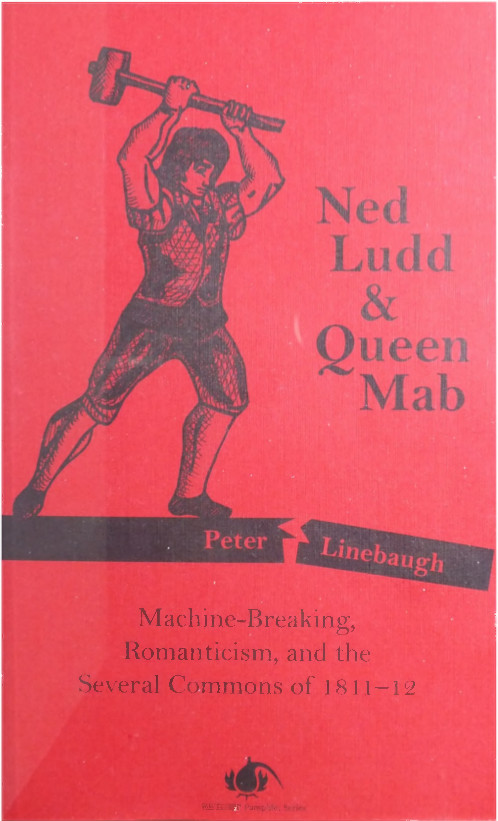Peter Linebaugh: Ned Ludd and Queen Mab: Machine-Breaking, Romanticism, and the Several Commons Of 1811-12 (2012)
Filed under pamphlet | Tags: · 1800s, luddism, machine, romanticism

“Peter Linebaugh, in an extraordinary historical and literary tour de force, enlists the anonymous and scorned 19th century loom-breakers of the English midlands into the front ranks of an international, polyglot, many-colored crew of commoners resisting dispossession in the dawn of capitalist modernity.”
Publisher PM Press, Oakland, CA, 2012
Report Pamphlet Series, No. 001
ISBN 9781604867046
48 pages
review (Alan Brooke)
author’s lecture on luddism (audio)
Meta F. Janowitz, Diane Dallal (eds.): Tales of Gotham, Historical Archaeology, Ethnohistory and Microhistory of New York City (2013)
Filed under book | Tags: · 1600s, 1700s, 1800s, anthropology, archaeology, city, ethnoarchaeology, ethnography, history, new york

“Historical Archaeology and Ethnohistory of New York City: Tales and Microhistory of Gotham is a collection of narratives about people who lived in New York City during the seventeenth, eighteenth, and nineteenth centuries, people whose lives archaeologists have encountered during excavations at sites where these people lived or worked. The stories are ethnohistorical or microhistorical studies created using archaeological and documentary data. As microhistories, they are concerned with particular people living at particular times in the past within the framework of world events.
The world events framework will be provided in short introductions to chapters grouped by time periods and themes. The foreword by Mary Beaudry and the afterword by LuAnne DeCunzo bookend the individual case studies and add theoretical weight to the volume. Topics in the book include:
– Native Americans and Europeans in New Amsterdam
– Stories of Dutch women in the colonial period
– African history in New York City, including the African Burial Ground
– Craftsmen and Churchmen of New York City
– A portrait of Stephen Allen, a New York City Mayor
Historical Archaeology and Ethnohistory of New York City: Tales and Microhistory of Gotham focuses on specific individual life stories, or stories of groups of people, as a way to present archaeological theory and research. Archaeologists work with material culture—artifacts—to recreate daily lives and study how culture works; this book is an example of how to do this in a way that can attract people interested in history as well as in anthropological theory. As such, this volume is an invaluable resource for archaeologists, historians, ethnographers, anthropologists, and anybody interested in the rich history of one of the world’s most influential cities, New York City.”
With a Foreword by Mary Beaudry
With an Afterword by LuAnne DeCunzo
Publisher Springer, London, 2013
ISBN 1461452716, 9781461452713
369 pages
Susan Buck-Morss: The Dialectics of Seeing: Walter Benjamin and the Arcades Project (1989–) [English, Spanish]
Filed under book | Tags: · 1800s, advertising, bourgeoisie, city, commodification, critical theory, cultural criticism, fashion, flaneur, history, literary criticism, literature, paris, photography, poetry

“Walter Benjamin‘s magnum opus was a book he did not live to write. In The Dialectics of Seeing, Susan Buck-Morss offers an inventive reconstruction of the Passagen-Werk, or Arcades Project, as it might have taken form.
Working with Benjamin’s vast files of citations and commentary which contain a myriad of historical details from the dawn of consumer culture, Buck-Morss makes visible the conceptual structure that gives these fragments philosophical coherence. She uses images throughout the book to demonstrate that Benjamin took the debris of mass culture seriously as the source of philosophical truth.
The Paris Arcades that so fascinated Benjamin (as they did the Surrealists whose “materialist metaphysics” he admired) were the prototype, the 19th century ‘ur-form’ of the modern shopping mall. Benjamin’s dialectics of seeing demonstrate how to read these consumer dream houses and so many other material objects of the time—from air balloons to women’s fashions, from Baudelaire’s poetry to Grandville’s cartoons—as anticipations of social utopia and, simultaneously, as clues for a radical political critique.
Buck-Morss plots Benjamin’s intellectual orientation on axes running east and west, north and south—Moscow Paris, Berlin-Naples—and shows how such thinking in coordinates can explain his understanding of ‘dialectics at a standstill’. She argues for the continuing relevance of Benjamin’s insights but then allows a set of “afterimages” to have the last word.”
Publisher MIT Press, 1989
Studies in Contemporary German Social Thought Series
ISBN 0262022680
493 pages
Reviews: Shierry Weber Nicholsen (New German Critique, 1990), Robert Tobin (Phil and Lit, 1991), James L. Gussen (Germanic Review, 1992), Erika Berroth (J Germanic Linguistics, 1994), Beste Alpay (Montréal Review, 2011).
Publisher (EN)
The Dialectics of Seeing: Walter Benjamin and the Arcades Project (English, 22 MB, updated on 2019-12-3)
Dialectica de la mirada: Walter Benjamin y el proyecto de los Pasajes (Spanish, trans. Nora Rabotnikof, 1995, updated on 2013-5-2)

